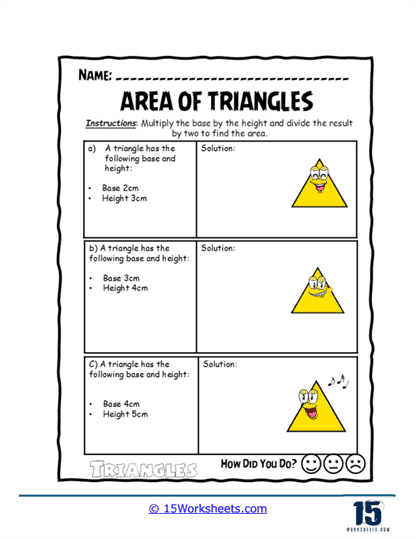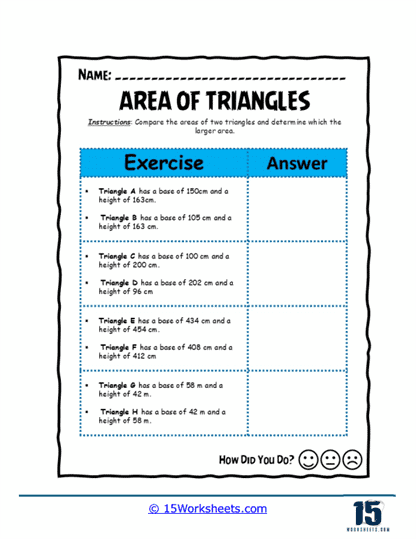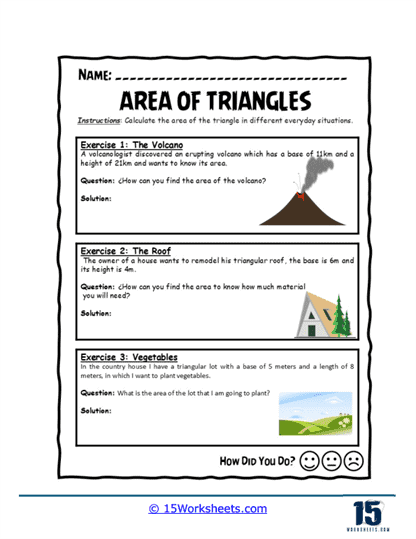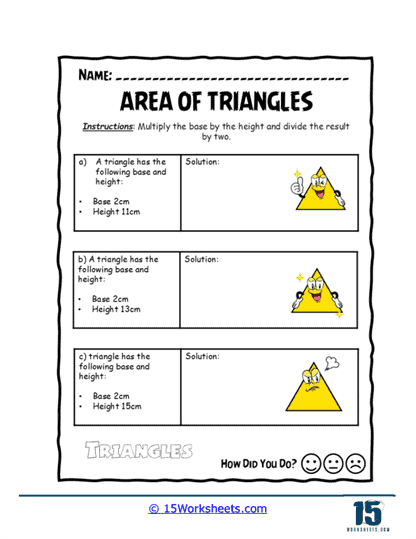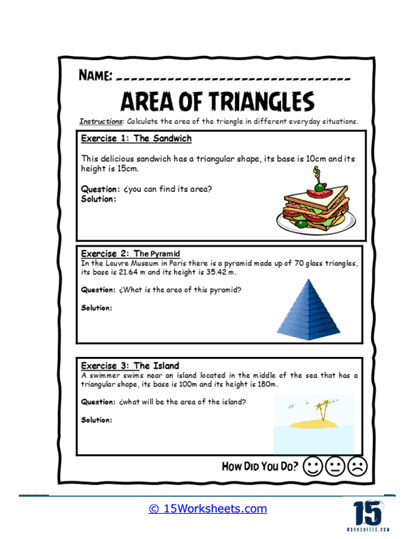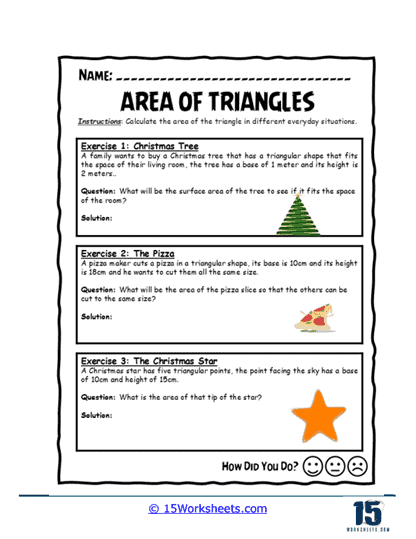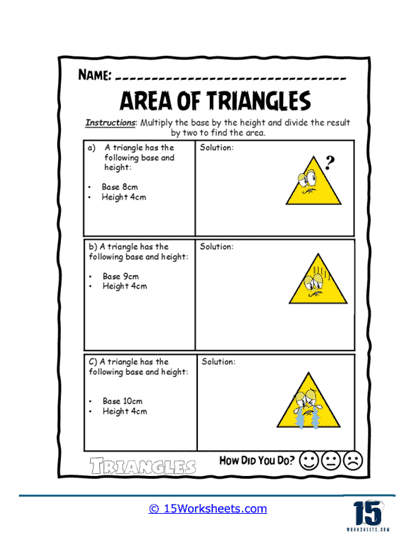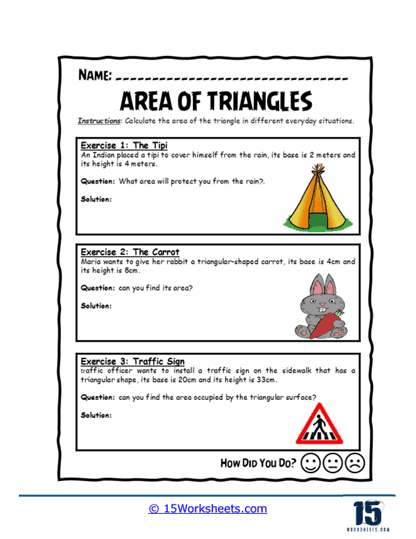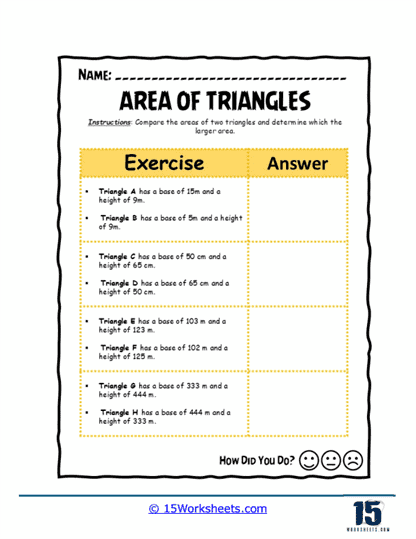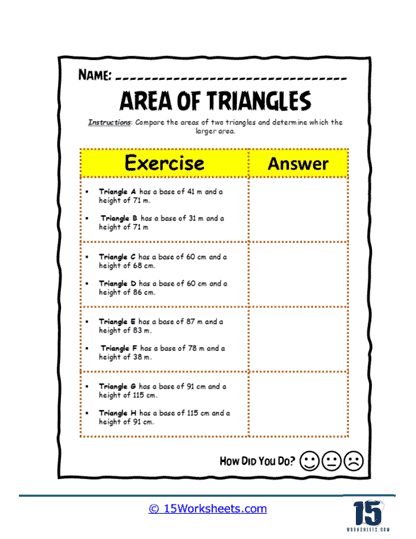Area of Triangles Worksheets
About Our Area of Triangles Worksheets
Unlock the full potential of geometric learning with this comprehensive worksheet collection! Designed to provide structured and engaging practice, these worksheets guide students through the core principles of triangle area calculations using various methods and applications. Whether you’re a teacher seeking classroom resources, a parent looking for supplementary materials, or a student eager to master this fundamental geometry concept, this collection offers clear, well-structured exercises that make learning both effective and enjoyable.
These printable PDFs include a variety of problems, from basic conceptual drills to real-world application tasks, ensuring that students build both confidence and competence in calculating the area of triangles. Through a mix of guided practice, challenge problems, and creative activities, learners will develop a strong foundation in geometry while also honing their problem-solving and analytical thinking skills.
Key Features
This worksheet collection is thoughtfully designed to cater to different learning styles while reinforcing the key concepts of calculating the area of triangles. The structured progression of exercises ensures a step-by-step mastery of the topic.
Fundamental Practice: Straightforward calculations using the standard area formula: Area = ½ x base x height
- Identifying base and height from given triangles.
- Applying formulas to solve for missing values.
Visual and Interactive Problems:
- Labeling exercises where students identify key triangle components.
- Diagram-based calculations that reinforce spatial reasoning.
- Fill-in-the-blank questions to reinforce conceptual understanding.
Multi-Step and Application-Based Problems:
- Word problems involving real-world scenarios (e.g., construction, architecture, and art).
- Complex triangles (right, scalene, isosceles) and their unique area considerations.
- Using the Pythagorean Theorem to find missing dimensions before calculating the area.
Higher-Level Thinking Tasks:
- Problem-solving challenges requiring logical deduction and reasoning.
- Composite shape breakdowns, where students calculate the area of triangles within larger figures.
- Exploration of Heron’s Formula, providing an advanced perspective on non-right triangles.
Creative and Engaging Exercises:
- Draw-and-calculate tasks, where students sketch triangles based on given measurements and compute the area.
- Math riddles and puzzles to reinforce learning in a fun way.
- Real-life applications connecting math to everyday experiences.
Skills Developed
Mathematics is more than just numbers and formulas-it is a tool that helps students develop logical thinking, problem-solving abilities, and analytical skills that extend beyond the classroom. This Area of Triangles Worksheet Collection is carefully designed to support students in mastering both fundamental and advanced mathematical skills while also fostering a deep understanding of geometric principles. Through structured exercises, students will not only learn how to calculate the area of triangles but also develop critical thinking strategies that will serve them well in higher-level math and real-world problem-solving.
Mastery of the Triangle Area Formula
One of the foundational goals of these worksheets is to help students become fluent in using the standard area formula for triangles:
Area = ½ x base x height
While the formula may seem simple at first glance, applying it correctly requires a clear understanding of how to identify the base and height in different triangle orientations. The worksheets guide students through a step-by-step approach to recognizing these key components, ensuring that they can accurately calculate the area in various scenarios. By the end of these exercises, students will have developed automaticity and confidence in using this essential geometric formula.
Application of Algebraic Concepts
Understanding the area of triangles is not just about memorizing a formula; it also involves the ability to manipulate and solve algebraic expressions. These worksheets introduce problems where students must work backward from a given area to find missing triangle dimensions, reinforcing essential algebraic skills such as solving for unknowns. This approach helps students see the interconnectedness of geometry and algebra, deepening their mathematical proficiency.
Many exercises require students to rewrite equations to express different variables in terms of others, a skill that is crucial in higher-level math courses such as algebra, trigonometry, and calculus. By engaging with these problems, students strengthen their ability to analyze and rearrange mathematical expressions, a skill that will benefit them far beyond this topic.
Understanding Different Triangle Types
Triangles come in many shapes and sizes, each with unique properties that influence how we calculate their area. These worksheets cover a wide range of triangle classifications, including equilateral, isosceles, scalene, and right triangles. Students will learn to recognize how different side lengths and angles impact the calculation process, ensuring they can confidently approach any triangle-related problem.
In particular, students will explore right triangles, where the base and height are easily identified, as well as more complex cases where height must be determined indirectly. By working through these variations, students develop flexibility in their problem-solving approaches, enabling them to tackle a diverse set of mathematical challenges with ease.
Advanced Geometric Problem-Solving
For students ready to take their understanding to the next level, these worksheets introduce complex geometric applications that encourage higher-order thinking. One of the advanced topics covered is Heron’s Formula, a method used to calculate the area of a triangle when only the side lengths are known. This allows students to move beyond the traditional base-height formula, expanding their mathematical toolkit.
Students will engage in multi-step problems that require breaking down composite figures into smaller, manageable triangles. This type of analysis is crucial in fields such as architecture, engineering, and physics, where geometric reasoning plays a fundamental role. By working through these challenges, students enhance their logical reasoning and spatial visualization skills, preparing them for more advanced coursework and practical applications.
Real-World Applications
Mathematics is most powerful when it connects to real-life situations, helping students see the relevance of what they are learning. The ability to calculate the area of triangles is not just an academic skill-it is a practical tool used in many different fields and everyday activities. These worksheets go beyond theoretical exercises, incorporating real-world problems that demonstrate how geometry is applied in professional industries, technology, and even outdoor activities.
Architecture & Construction
Triangles are one of the most stable and widely used shapes in construction and architecture. Engineers and architects frequently calculate triangular areas when designing roofs, bridges, and support structures. Understanding how to determine these areas helps in estimating material costs, ensuring accurate measurements, and optimizing structural integrity.
For example, a builder constructing a triangular roof truss must calculate the exact area to determine how much metal or wood is needed. Through practical word problems, students will see how their math skills directly relate to real-world design and construction challenges.
Engineering & Design
Engineers and industrial designers rely heavily on geometric principles to create functional and efficient designs. Whether working with automotive frames, aerospace structures, or product designs, professionals often use triangular components because of their strength and versatility.
Many of the exercises in this collection introduce scenarios where engineers need to optimize materials, demonstrating how knowing the area of triangular sections can help in the development of stronger and lighter structures. By engaging with these applications, students gain insight into how math is used in technological innovation and problem-solving.
Art & Graphic Design
Geometry is not just about numbers-it is also about creativity and aesthetics. In graphic design, photography, and art, triangles play a crucial role in creating balanced compositions and dynamic layouts. From designing logos to planning the structure of paintings, understanding triangular areas can help artists arrange elements proportionally and effectively.
These worksheets include creative tasks where students design their own geometric patterns, reinforcing the connection between mathematical concepts and artistic expression. This integration of math and creativity helps students see geometry as a versatile and engaging subject, rather than just a series of equations.
Physics & Astronomy
In scientific fields such as physics and astronomy, the study of triangles is fundamental. One of the most well-known applications is triangulation, a method used to measure distances that are otherwise difficult to determine, such as the distance between planets or the height of mountains.
By working through exercises that introduce these ideas, students will gain an appreciation for how geometry is used in scientific discovery. Learning to apply triangle area calculations in physics problems helps them prepare for future studies in STEM fields, where mathematical reasoning is essential.
Outdoor & Recreational Activities
Beyond academic and professional applications, knowing how to calculate the area of triangles is useful in many day-to-day activities. For example, landscapers and gardeners use triangular measurements to determine how much soil or grass is needed for a plot of land. Similarly, hikers and rock climbers often use angles and elevation calculations to assess their routes and safety measures.
Athletes and sports analysts also apply these concepts when calculating distances, angles, and trajectory paths in various sports. Whether it’s understanding the angle of a soccer kick or the slope of a ski ramp, these real-world applications help students recognize the importance of mathematical skills in their hobbies and interests.
Mastering the area of triangles is more than just an academic exercise-it is an essential mathematical skill that bridges the gap between theory and real-world application. This carefully designed worksheet collection provides students with a structured and engaging approach to understanding triangular geometry, allowing them to build confidence in problem-solving while developing a deeper appreciation for how math is used in everyday life. By progressing through fundamental calculations, tackling real-world challenges, and engaging in creative tasks, learners not only refine their computational abilities but also enhance their logical reasoning and analytical skills. These worksheets cater to a wide range of learning styles and abilities, ensuring that all students can grasp the underlying principles of triangle area calculations, whether they are just starting or ready for more advanced problem-solving strategies.
Beyond the classroom, the ability to calculate the area of triangles is a skill with far-reaching implications, from engineering and architecture to graphic design and outdoor activities. By incorporating real-world scenarios, these worksheets encourage students to see mathematics as a valuable tool for interpreting and solving practical problems. Whether designing a building, analyzing sports performance, or exploring the wonders of space, students will come to appreciate how geometric principles shape the world around them. With this well-rounded and thoughtfully structured worksheet collection, learners are not only prepared for academic success but also equipped with the mathematical foundation needed for lifelong problem-solving and innovation.

